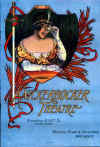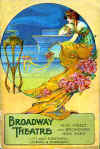Demolished Broadway Theatres - A to B
Compiled by John Kenrick
Copyright 2009
(The images below are thumbnails – click on them to see larger versions.)
- Abbey's
- Academy of Music
- American (African)
- American
- ANTA
- Astor
- Astor Place
- Avon
- Barnum's Museum
- Barnum's New Museum
- Belmont
- Bijou
- Bijou Opera House
- Booth's
- Bowery
- Bowery Amphitheatre
- Broadway (Assorted locations)
- Broadway (41st Street)
- Brougham's Lyceum
- Bryant's Opera House
- Burton's Chamber Street
 Abbey's
Abbey's
1394 Broadway at 38th Street
Built: 1893
Later named: Knickerbocker (1896)
Demolished: 1930
Seats: 1,500
Architect: J. B. McElfatrick & Co.
History: Originally named for impresario Henry Abbey.
Home to several hit musicals, it was a bit south of Times Square, and
fell into disuse. It was demolished in 1930 along with its neighbor,
the Casino.
Noteworthy Musicals: Mlle. Modiste (1905), Red Mill (1906),
Dearest Enemy (1925), Honeymoon Lane (1926)
Academy of Music
14th Street between 3rd Avenue and Irving Place
Built: 1854
Demolished: 1926
History: One of New York's first world-class venues for theatre and
opera, a fire here in 1866 left a ballet troupe stranded – they wound
up in the historic Niblo's Garden production of The Black Crook. The Academy was
rebuilt and remained popular for decades, but as the neighborhood changed in the early 20th century,
upper class audiences drifted uptown. The auditorium was used as a vaudeville
and film house until its demolition in 1926.
Adelphi - see Craig
American (African)
1215 Mercer Street (at Houston)
Built: 1822
History: Former ship steward William Brown, a free born Caribbean man of
color, presented the first African American stage entertainments seen in
New York. He built the American Theatre (which white journalists
referred to as the African) after success with an 1821 pleasure garden
in Greenwich Village. Brown's success soon drew hostile response from
white theatre owners, journalists, and racist mobs. He was forced to close down in
1823.
American
Eighth Avenue between 41st and 42nd Streets
Built: 1893
Later Named: American Music Hall
Demolished: 1932
History: In the 1890s this was home to Henry W. Savage's Castle Square
Opera Company, which staged dozens of operetta revivals. Considered a
liability because of its Eighth Ave. location, it later housed
vaudeville, movies and burlesque.
ANTA - see Virginia
Astor
1537 Broadway
Built: 1906
Demolished: 1982
Seats: 1,500
Architect: George Keister
History: One of Broadway's most desirable theatres for almost two decades,
the Astor became a motion picture house from 1925 onwards, serving as MGM's
premiere New York venue. It underwent an ugly modernization in 1959 and
continued showing films until 1972. After brief stints as retail and
storage space, the building sat deserted for several years until it was leveled
to make way for the Marriott Marquis Hotel.
Musicals: Tom Jones (1908), Hello Broadway (1914), June
Days (1925)
Astor Place Opera House
East Eighth Street and Astor Place
Built: 1847
Later named: Theatre Francaise, Clinton Hall
Demolished: 1860s?
History: Catering to New York's upper classes, this was the site
of the infamous Astor Place Riot in 1849. A mob of jingoistic Irish immigrants
violently protested against the appearance of a British actor, and were fired on
by police – at least eighteen died and hundreds were injured. The Astor
tried to carry on, but memories of the riot made most managers unwilling
to book events there. Becoming the Clinton Hall library in 1854, it was
used as a lecture hall in the 1860s.
Noteworthy Musicals: A minstrel troupe appeared here in 1853.
Avon - see Klaw
Barnum's American Museum
Broadway & Ann St. (SE Corner)
Original name: Scudder's American Museum
Built: 1800 (approx.)
Demolished: 1865 (fire)
History: This building serves as New York City's poorhouse for a
decade before it became Dr. Scudder's
American Museum in 1810. P.T. Barnum bought the Museum in 1841, converting it into a
popular tourist attraction noted for presenting bizarre exhibits and respectable plays. In 1850,
he enlarged the lecture hall into a handsome 3,000 seat auditorium. Respectable people who
were leery of theatres felt comfortable attending
performances at a "museum," and Barnum presented an ongoing
series of plays, minstrel shows and clean variety bills. Despite what
you see in the fanciful film Gangs of New York, this theatre was
not destroyed during the draft riots of 1863. After fifteen
years as one of the most celebrated playhouses in New York, Barnum's
Museum burned to the ground accidentally in 1865. The location became
the new home for the offices of the NY Herald,
and Barnum opened his New Museum (see below) at 539 Broadway.
Noteworthy musicals: Ondina (1861), Hop O' My Thumb
(1862)
Barnum's New Museum
539-41 Broadway
Also named: The Chinese Rooms, Buckley's Minstrel Hall (1853)
Built: 1851
Demolished: 1868 (fire)
History: When P.T. Barnum's American Museum burned to the ground
in 1865, he soon re-opened in this onetime minstrel hall, offering
daily "educational" performances. When this structure burned
three years later, Barnum suspended his theatrical endeavors.
Belmont - see Jack Norworth
Bijou
209 West 45th Street
Built: 1917
Demolished: 1982
Seats: 365
Architect: Herbert J. Krapp
Owners: The Shuberts
History: This house was too small to be commercially attractive
to producers.
It's only long runs were for A Moon for the Misbegotten (1957)
and the mime revue Mummenschanz. It was one of five theatres
demolished to make way for the Marriott Marquis Hotel.
Bijou Opera House
1239 Broadway (Between 20th & 31st Streets)
Also named: The Brighton, The Bijou Opera House
Built:1800s
Demolished: 1915
This onetime "sporting" saloon was converted into an intimate
theatre in 1878. Completely re-built in 1883, it became a popular venue
for operettas. It served as a silent movie house until it was torn down
to make way for yet another office building.
Booth's
SE Corner of 23rd Street and Sixth Avenue
Built: 1869
History: Built by tragedian Edwin Booth, this was one of the most
ornate theatres in New York. Successful productions
of Hamlet, Richelieu and other classics could not make up
for Booth's lack of business acumen, and he lost the theatre to
bankruptcy in 1874. After various managers, it was sold off as retail
space in 1883. A bust of Shakespeare that once adorned the facade of the
theatre can still be seen on the office building that currently stands
at this location.
Noteworthy Musicals: Humpty Dumpty in Every Clime (1875)
Bowery
46 Bowery
Built: 1826
Later named: American (1831-32), Thalia
Demolished: 1929 (fire)
History: Built on the site of the Bull's Head Tavern, The Bowery
was the first NY theatre lit by gas. It burned down several times (1828,
1836, 1838, 1845, 1923) but was so popular that it was rebuilt time and again, becoming the first American theatre
location to remain in almost constant use for more than 100 years. Undergoing numerous
changes of management, The Bowery offered a wide variety of entertainments
aimed at working class audiences. For many years, its impressive columned facade was
partially obscured by elevated subway tracks. Renamed
the Thalia, this house spent spent its final years as a home for Yiddish
theatre, where it housed performances by Jacob Adler and Boris
Thomaschevsky -- competing Yiddish productions played across the street
at the Windsor.
By the time The Bowery suffered its sixth fire
on June 5, 1929, the neighborhood had fallen on hard times, and the
owners sold off the property for business use. A Chinese market
currently stands on this location.
Bowery Amphitheatre
Built: 1835
Later named: Stadt (1854)
Demolished: Unknown
Originally an animal menagerie, this structure stood almost directly
across the street from the more prestigious Bowery. It was converted to
theatrical use in the 1840s. It housed the birth of minstrelsy in 1843,
and served as a German-language theatre for some time before being
converted to use as an armory in the mid-1860s.
Noteworthy Musicals: The Virginia Minstrels (1843)
Broadway
Many New York theatres have held this name. The early examples include:
- 410 Broadway (1837) - Euterpean Hall was renamed "The Broadway Theatre" in 1837 and demolished several months later.
- 326-328 Broadway (1847-1859) - Sometimes referred to as "the Old Broadway," this 4,500 seat house knew relatively few hits and was demolished after twelve years.
- 728 Broadway (1865) - Built as a Unitarian Church, this theatre was called "The Broadway" when pantomime star George L. Fox played his final New York run of Humpty Dumpty there in 1865. The building had various names and managers in the years that followed, and after extensive renovations became Harrigan and Hart's new Theatre Comique from 1881 to 1884 -- when it burned to the ground.
- 485 Broadway (demolished 1869) - Built as Brougham's Lyceum in 1850, it was known as The Broadway in the late 1860s.
- 1221 Broadway - (demolished 1920) Augustin Daly managed this converted museum from 1879-1899. A vaudeville and movie house from 1900 onwards, it was occasionally known as "The Broadway Theatre."
 Broadway (41st St.)
Broadway (41st St.)
1445 Broadway at 41st Street (SW Corner)
Built: 1888
Demolished: 1929
Seats: 1,700
Architect: J. B. McElfatrick & Sons
History: Designed for large scale musicals, this handsome
theatre also housed the long-running Ben Hur and a number of
Shakespearean productions. The Broadway became a vaudeville
and movie house in 1920s and was demolished one year before the current Broadway Theatre at 53rd Street
took over the name.
Noteworthy Musicals: Wang (1891), The Lion Tamer
(1891), Utopia Ltd. (1894), El Capitan (1896), The
Highwayman (1897), The Silver Slipper (1902)
Brougham's Lyceum
- see Broadway (485)
Bryant's Opera House
- see Koster & Bial's
Burton's Chamber Street
- see Palmo's Opera House
